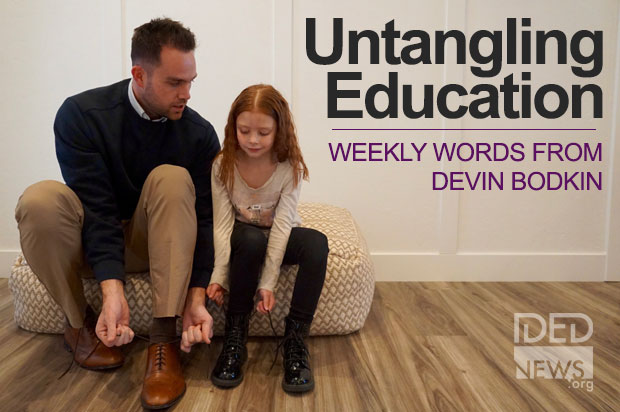My wife and I rolled up to Middleton High School last week with the kids, who pointed out quickly that it didn’t look like the high school where we’re from.
Middleton High’s bigger, though ours serves almost as many students. The football stadium has at least twice as many seats, and the field isn’t grass like ours back home. It’s turf, the kind with little rubber chunks that cushion falls and prevent skin burns.
Inside a big glass entryway, we were greeted by a gym with an airy mezzanine overlooking the basketball court.
We don’t have one of those back home, either.
And then there were the lofty ceilings, and natural light pouring in from windows everywhere.
For our kids, the flashier school was just part of a brief getaway mostly spent cheering on a cousin at the girls’ state hoops tournament.
Still, the differences were clear.
I’m not complaining. Our district’s older schools have served us well. But the reality in Idaho is that schools in different communities can look … different. Very different. They can also give kids in one area access to things that kids in another area lack, like bigger classrooms with air conditioning, a spacious area for students to hang out in during downtime or little rubber chunks in their football field.
There’s a reason for the disparities, and it starts with your zip code.
In Idaho, property owners bankroll school construction costs through bonds, which must gain two-thirds support from local voters to pass. The money comes from property taxes generated from homes, farms and businesses within a school district’s boundaries.
And because the landscape of homes, farms and businesses varies greatly from community to community, so does a district’s ability to tap into the kind of tax base capable of absorbing that big-money school the local PTA could only dream of.
That’s one reason school leaders follow new construction closely in their districts. Last week’s news of an $800 million Facebook facility in Kuna spread fast, but a facility of that value can also provide a big boost to a district’s tax base.
But there are sprawling Facebook data centers and there are Idaho’s potato fields, which don’t exactly drum up the same kind of tax revenue.
I saw this reality play out in 2017 in the Sugar-Salem district, which is surrounded by a sea of potato fields and, consequently, fell to the bottom of a statewide comparison of local market values in Idaho’s school districts at the time. (My district was third from the bottom.)
I stood outside with Sugar Salem’s then-superintendent Alan Dunn, who winced at a district maintenance shop that he seemed convinced could topple over any moment. School construction could only be done on a piecemeal basis in Sugar-Salem at the time because the district couldn’t bond for new facilities in one swipe. Aside from getting enough local voters to approve a measure, Idaho law caps school bond issues at 5% of a district’s total market value.
There was a small silver lining. Dunn pointed to plans for a Walmart to be built nearby. Not an $800 million Facebook data center, but a big boost to the most property-poor district’s tax base.
And Sugar-Salem isn’t the only district that’s struggled to upgrade infrastructure. In 2013, the state swooped in to bankroll $3.6 million in repairs to two aging schools in the rural Salmon district after local voters rejected bond issues nine times over eight years.
There are trade-offs, of course. For some, country living cancels out the older and smaller schools that often come with it. Some people just don’t want a Facebook data center in the potato field behind their house — or to trade country roads for the traffic that often comes with the healthiest of tax bases.
And I’ve been impressed by the schools some of our rural nearby communities have been able to build over the years. Our district managed to pass a bond issue for a new elementary school last year — months after we moved into another school’s boundaries across town.
I’d love for our kids to get a new and improved school, but I also love our small town in the heart of potato country. Ask my wife and kids, who had to drive around in Boise traffic with me all weekend.
Whatever your view, it could become harder — not easier — for your district to build and upgrade its schools, with news of a bill that would ban schools from running “repeat” bond requests advancing through the Statehouse this session.
That turf and rubber chunks for a football field just might have to wait.
Meanwhile, the March 8 election is sneaking up on us and features several districts hoping to tap into local funds for new or improved facilities.
Four will have a combined $176.9 million in bond issues on the ballot. Four others are asking for a combined $26.9 million via plant facilities levies, which have a maximum term of 10 years, can only be used for capital projects but not normally for new facilities.
A closer look:
Bond issues:
- Boundary County: $16.4 million for a new elementary school.
- Jefferson County: $80 million for a new middle school and other construction projects.
- Madison: $25.5 million for a new middle school and other upgrades.
- Vallivue: $55 million for two new elementary schools.
Plant-facilities levies:
- Highland: a five-year, $250,000 proposal.
- Idaho Falls: a 10-year, $24.4 million levy.
- Mackay: a five-year measure for $748,664.
- Valley: a five-year, $1.5 million proposal.

